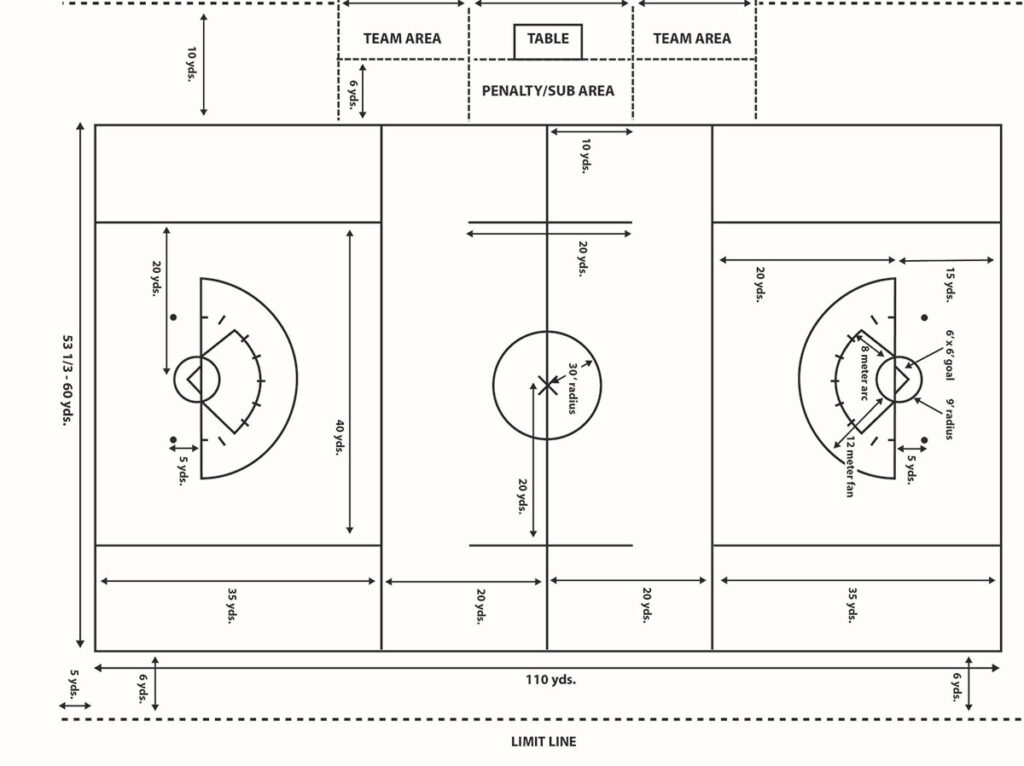Lacrosse is a fast-paced sport that requires skill, strategy, and teamwork. Played with a small rubber ball and a long-handled stick, lacrosse has a rich history that traces its roots back to Native American culture. Today, the sport continues to grow in popularity around the world. However, like any sport, lacrosse has rules that must be followed to ensure fair play and player safety.
USA Lacrosse works collaboratively with the National Federation of State High School Associations (NFHS) and the NCAA to write the rules for the sport. The rules are designed to promote fair play and keep players safe. USA Lacrosse is committed to constantly reviewing and updating the rules of the game to ensure that those goals are always satisfied.
Whether you are a beginner or a seasoned player, understanding lacrosse rules is essential to enjoying and playing the game well. This article will provide an overview of the rules of this sport, including information on equipment, gameplay, penalties, and more.
Object of the Game
Lacrosse is a team sport involving two teams of ten players each, each trying to score more goals than the other team. The game is played with a small rubber ball, and a long-handled stick called a crosse. The object of the game is to shoot the ball into the opponent’s goal and score more goals than the other team.
The game starts with a face-off in the middle of the field, and the team that gains possession of the ball is on offense. The offensive team tries to pass the ball around and create scoring opportunities by moving the ball toward the opponent’s goal. The defensive team tries to prevent the offensive team from scoring by intercepting passes, checking players, and forcing turnovers.
The game is divided into four quarters, each lasting 15 minutes, with a halftime break in between the second and third quarters. The team with the most goals at the end of the game wins. In the event of a tie at the end of regulation time, the game may go into overtime, where the first team to score wins.
It is important to note that players are not allowed to touch the ball with their hands or feet, except for the goalie who is allowed to use their hands to catch and throw the ball. Players must use their crosse to scoop, cradle, pass, catch, and shoot the ball. Additionally, players are not allowed to make physical contact with other players using their bodies or crosse, except for legal checking.
(Follow this guide to learn how to play lacrosse)
Gameplay
Lacrosse is a fast-paced, physical game that requires players to use a combination of speed, agility, and skill to outscore their opponents. The game is played on a field that measures 110 yards in length by 60 yards in width, with goals at either end measuring six feet by six feet. The goal is surrounded by a circular “crease” with a diameter of 18 feet.

Field and Equipment
The lacrosse field is divided into two halves by the midfield line. The offensive and defensive halves of the field are further divided by the restraining line, which is located 20 yards from each goal line. Players must stay on their respective sides of the restraining line until possession of the ball has been established.
Each player uses a lacrosse stick with a mesh netting to catch, carry, and pass the ball. The stick is made up of several components, including the head, shaft, and pocket. The head is the part of the stick that holds the mesh netting and is used to catch and throw the ball. The shaft is the long, cylindrical part of the stick that the player holds onto. The pocket is the area of the mesh netting where the ball is caught and carried.
Players must wear protective equipment, including a helmet, gloves, shoulder pads, and arm pads. Goalkeepers wear additional padding to protect themselves from shots on goal.
Players and Positions
Each team is made up of 10 players: a goalkeeper, three defenders, three midfielders, and three attackers. The goalkeeper is the only player allowed to use their hands to touch the ball while in the crease. Defenders are responsible for preventing the other team from scoring, while attackers are responsible for scoring goals. Midfielders play both offense and defense and are responsible for transitioning the ball between the two halves of the field.
Scoring and Goals
The object of lacrosse is to score more points than your opponents at the end of four quarters, which last for 15 minutes each. A point is scored by throwing the ball across the goal line of the opponent’s goal. The ball must completely cross the goal line to count as a point.
Possession and Offsides
Teams must gain and maintain possession of the ball in order to score. Players are not allowed to touch the ball with their hands or feet, except for the goalkeeper while in the crease. Players must also stay on their respective sides of the midfield line until possession of the ball has been established.
Offsides occurs when a team has more than six players on one side of the midfield line. This results in a turnover of possession and a penalty for the offending team.
Face-Offs
A lacrosse faceoff occurs at the beginning of each quarter and after each goal. The ball is placed between two players at the center of the field, and they must use their sticks to try and gain possession of the ball.
Penalties
Penalties are given for various infractions, including slashing, tripping, and illegal body checks. Players who commit penalties are sent to the penalty box for a set amount of time, during which their team must play with one less player on the field.
High school lacrosse rules vary slightly from college and professional rules, so it is important to familiarize oneself with the specific rules of the league or tournament being played.
Box Lacrosse Rules
Box lacrosse is a variant of lacrosse that is played indoors on a smaller field. The game is played with two teams of six players each, including a goalie. The playing surface is typically made of artificial turf or concrete, and the walls around the field keep the ball in play at all times, resulting in a faster-paced, more physical game than its outdoor counterpart.
Box lacrosse has its own set of rules that differ from field lacrosse. For example, players are allowed to make contact with each other using their bodies and their sticks, and the shot clock is shorter, at 30 seconds, to encourage a faster pace of play. Additionally, players are required to wear helmets, gloves, and arm pads, and goalies wear additional padding to protect themselves from the harder shots that are common in the indoor game.
Substitutions in box lacrosse are made through a designated door on the bench, and players must enter and exit the field through this door. The game is typically played in four 15-minute quarters, with a halftime break in between.
Box lacrosse is a popular variant of the sport in Canada, where it is known simply as “lacrosse.” The National Lacrosse League (NLL) is the top professional league for box lacrosse in North America, with teams in both the United States and Canada.
Youth Lacrosse Rules
Youth lacrosse is a great way for children to learn the fundamentals of the sport and develop their skills. USA Lacrosse provides a comprehensive guide to youth lacrosse, including the rules of the game, equipment requirements, and player safety guidelines.
One of the key differences between youth lacrosse and other levels of play is the field size. For example, in boys’ lacrosse, the field is typically smaller than at the high school or college level. Additionally, there may be fewer players on the field, depending on the age group.
Another important consideration in youth lacrosse is safety. USA Lacrosse has established guidelines for player safety, including mandatory equipment requirements and rules to prevent dangerous play. For example, body checking is not allowed in youth lacrosse until a certain age group, to reduce the risk of injury.
USA Lacrosse also provides resources for coaches and parents to help ensure a positive experience for youth lacrosse players. This includes guidance on coaching techniques, practice plans, and how to create a safe and supportive environment for young athletes.
High School Lacrosse
High school lacrosse is a popular sport in the United States, played by both boys and girls. The rules of high school lacrosse are similar to those of college and professional lacrosse, with a few minor differences.
One of the key differences in high school lacrosse rules is the length of the game. High school lacrosse games are typically shorter than college and professional games, with two 24-minute halves instead of four 15-minute quarters.
Another difference is the number of players on the field. High school lacrosse teams have 10 players on the field at a time, compared to 12 players in college and professional lacrosse. The field is also smaller in high school lacrosse, measuring 110 yards long and 60 yards wide.
High school lacrosse rules also place a greater emphasis on player safety. For example, players must wear helmets, mouthguards, and gloves at all times. Body checking is also limited to certain areas of the field and is only allowed when the player with the ball is within five yards of the ball.
Other important high school lacrosse rules include:
- Faceoffs occur at the start of each quarter and after each goal
- A player can only be in the crease if they are shooting or passing the ball
- Players cannot touch the ball with their hands, except for the goalie who is within the crease
- Stick checks are allowed, but body checks are limited to certain areas of the field
- Penalties result in the offending player being removed from the field for a set amount of time
Overall, high school lacrosse is a fast-paced and exciting sport that requires skill, athleticism, and teamwork. By following the rules and playing safely, players can enjoy the game while minimizing the risk of injury.

USA Lacrosse
USA Lacrosse is the national governing body of lacrosse in the United States. The organization is responsible for developing and promoting the sport at all levels, from youth to professional. USA Lacrosse works collaboratively with the National Federation of State High School Associations (NFHS) and the NCAA to write the rules for the sport. The organizations often work together on rule development and player safety efforts.
USA Lacrosse publishes the official rulebook for the sport, which covers everything from equipment requirements to gameplay rules [download rules 2022-2023 | Backup link]. The rulebook is updated annually to reflect any changes or modifications to the rules. In addition to the rulebook, USA Lacrosse provides resources and training for coaches, officials, and players to ensure that the sport is played safely and fairly.
One of the key initiatives of USA Lacrosse is to promote diversity, equity, and inclusion in the sport. The organization has developed programs and resources to help increase access to the sport for underrepresented groups, including people of color and those from low-income communities. USA Lacrosse also provides resources for LGBTQ+ athletes and coaches to ensure that they are able to participate in the sport in a safe and welcoming environment.
USA Lacrosse also oversees the national teams for men’s and women’s lacrosse. These teams compete in international competitions, including the World Lacrosse Championships. The organization is responsible for selecting and training the players, as well as providing support and resources to the coaching staff.
Besides learning the lacrosse rules, you may need to learn these 99 common lacrosse terms to be familiar with the sport and quickly start it.
![Lacrosse Rules [Download 2022 - 2023 pdf] Lacrosse Rules](https://laxez.com/wp-content/uploads/2023/04/Lacrosse-Rules.jpg)














